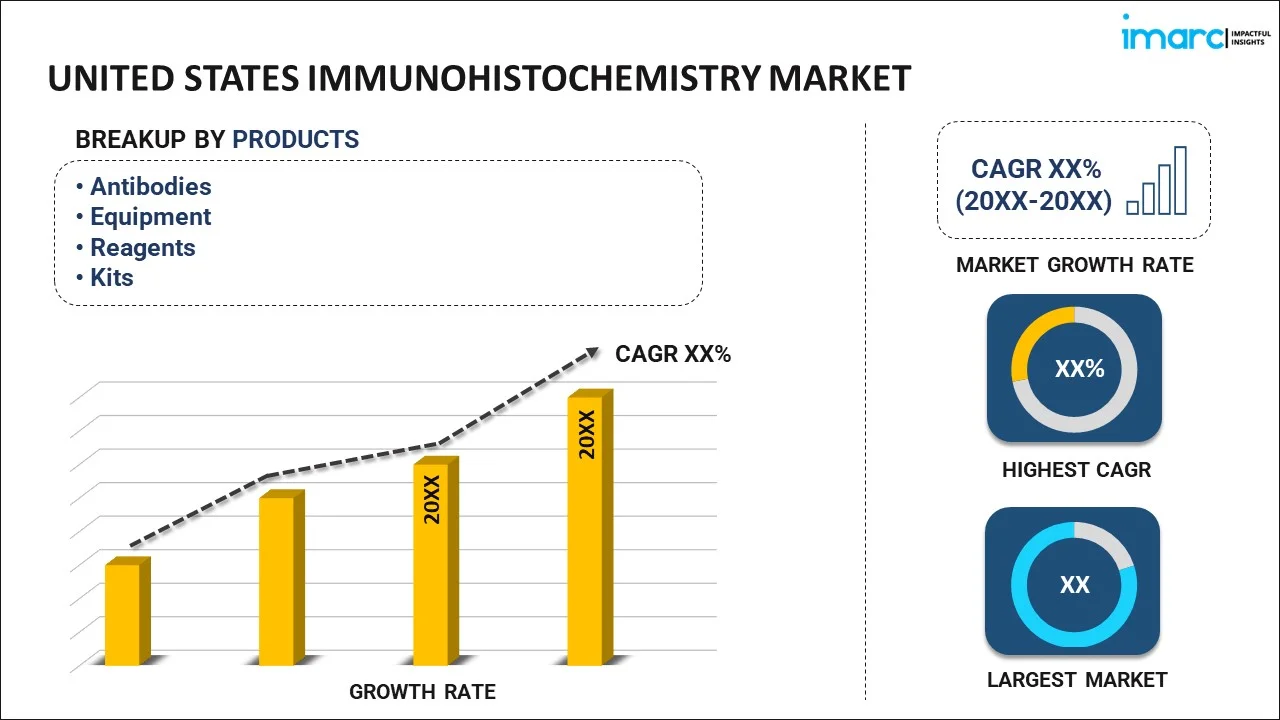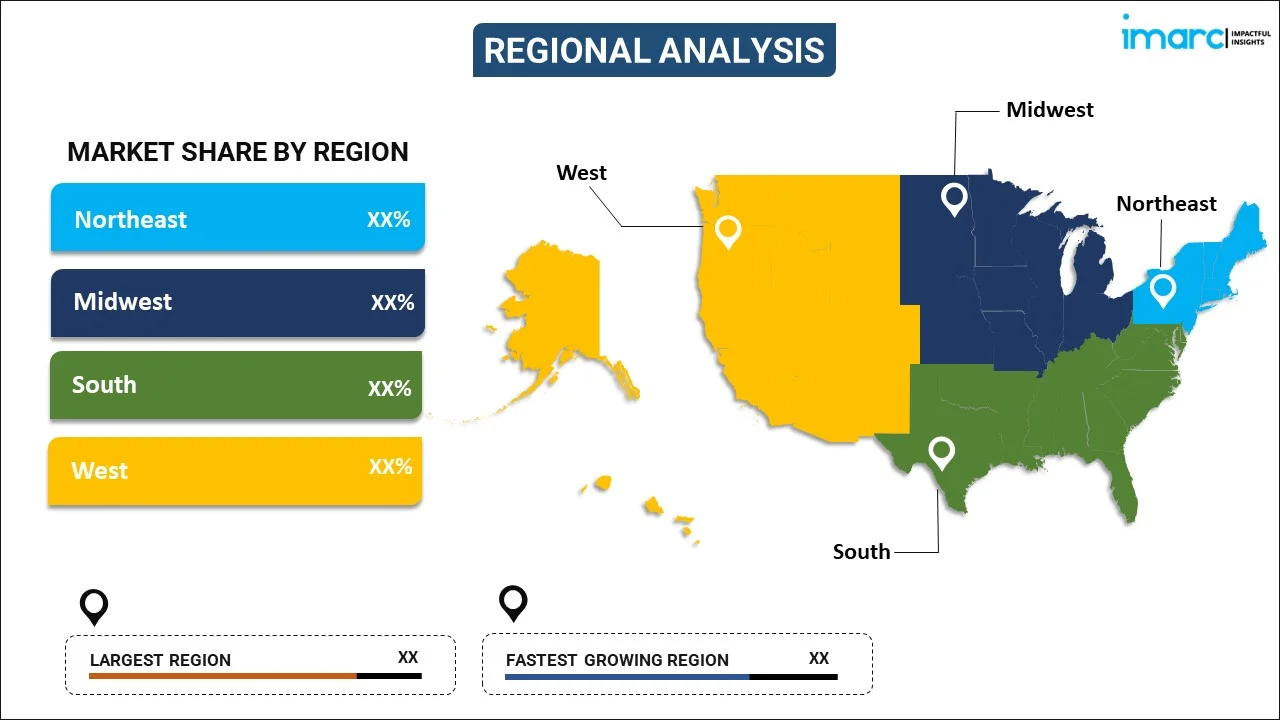
United States Immunohistochemistry Market Report by Product (Antibodies, Equipment, Reagents, Kits), Application (Diagnostics, Drug Testing), End Use (Hospitals and Diagnostic Laboratories, Research Institutes, and Others), and Region 2025-2033
Market Overview:
United States immunohistochemistry market size reached USD 642 Million in 2024. Looking forward, IMARC Group expects the market to reach USD 1,199 Million by 2033, exhibiting a growth rate (CAGR) of 7.2% during 2025-2033. The increasing chronic disease incidence, ongoing technological advancements, an aging population, rising demand for personalized medicine, research and development (R&D) investments, and supportive regulatory policies represent some of the key factors driving the market.
|
Report Attribute
|
Key Statistics
|
|---|---|
|
Base Year
|
2024
|
|
Forecast Years
|
2025-2033
|
|
Historical Years
|
2019-2024
|
|
Market Size in 2024
|
USD 642 Million |
|
Market Forecast in 2033
|
USD 1,199 Million |
| Market Growth Rate 2025-2033 | 7.2% |
Immunohistochemistry (IHC) is a laboratory technique widely employed in pathology and biomedical research to visualize the presence, distribution, and localization of specific proteins within tissues. It involves the use of antibodies that bind selectively to target proteins, forming a detectable complex through various visualization methods. The process begins with the preparation of tissue samples, typically obtained from biopsies or surgical specimens, followed by their fixation, sectioning, and mounting onto slides. These tissue sections are then treated with primary antibodies, which specifically recognize and bind to the target proteins of interest. Subsequently, secondary antibodies are applied, carrying markers, such as enzymes or fluorescent dyes that enable the visualization of the bound antibody complexes under a microscope. The resulting images provide valuable information about the spatial distribution and expression levels of specific proteins within cells and tissues. Immunohistochemistry plays a pivotal role in diagnostic pathology, aiding in the identification and characterization of diseases such as cancer, and research settings, contributing to a deeper understanding of cellular processes, disease mechanisms, and the development of targeted therapeutic approaches.
United States Immunohistochemistry Market Trends:
The rising incidence of chronic diseases, including cancer, has fueled the need for precise and early detection methods, primarily driving the demand for immunohistochemistry techniques in the United States. In confluence with this, significant technological advancements in the field of pathology and molecular biology leading to the development of more sophisticated and sensitive IHC assays, thereby enhancing their diagnostic accuracy and reliability, are strengthening the market growth. Moreover, the aging population in the United States is contributing to the growth of the IHC market, as older individuals are more susceptible to various diseases that necessitate precise diagnostic tools. In confluence with this, the growing awareness among both healthcare professionals and patients about the benefits of personalized medicine has increased the adoption of immunohistochemistry for targeted therapies, creating a favorable outlook for market expansion. Concurrently, the increasing investments in R&D activities by pharmaceutical and biotechnology companies spurring innovation in immunohistochemistry technologies has led to the introduction of novel reagents and assays, providing an impetus to the market growth. In addition to this, the expanding scope of IHC in academic research and clinical trials, as researchers and pharmaceutical companies leverage the technique to understand disease mechanisms and assess treatment efficacy, is acting as another significant growth-inducing factor. Furthermore, the rising emphasis on precision medicine and the emerging trend towards value-based healthcare, with immunohistochemistry’s ability to provide insights into individual patient responses to treatment is presenting lucrative opportunities for market expansion.
United States Immunohistochemistry Market Segmentation:
IMARC Group provides an analysis of the key trends in each segment of the market, along with forecasts at the country level for 2025-2033. Our report has categorized the market based on product, application, and end use.
Product Insights:

- Antibodies
- Primary Antibodies
- Secondary Antibodie
- Equipment
- Slide Staining Systems
- Tissue Microarrays
- Tissue Processing Systems
- Slide Scanners
- Others
- Reagents
- Histological Stains
- Blocking Sera and Reagents
- Chromogenic Substrates
- Fixation Reagents
- Stabilizers
- Organic Solvents
- Proteolytic Enzymes
- Diluents
- Kits
The report has provided a detailed breakup and analysis of the market based on the product. This includes antibodies (primary antibodies and secondary antibodies), equipment (slide staining systems, tissue microarrays, tissue processing systems, slide scanners, and others), reagents (histological stains, blocking sera and reagents, chromogenic substrates, fixation reagents, stabilizers, organic solvents, proteolytic enzymes, and diluents), and kits.
Application Insights:
- Diagnostics
- Cancer
- Infectious Diseases
- Cardiovascular Diseases
- Autoimmune Diseases
- Diabetes Mellitus
- Nephrological Diseases
- Drug Testing
A detailed breakup and analysis of the market based on the application have also been provided in the report. This includes diagnostics (cancer, infectious diseases, cardiovascular diseases, autoimmune diseases, diabetes mellitus, and nephrological diseases) and drug testing.
End Use Insights:
- Hospitals and Diagnostic Laboratories
- Research Institutes
- Others
The report has provided a detailed breakup and analysis of the market based on the end use. This includes hospitals and diagnostic laboratories, research institutes, and others.
Regional Insights:

- Northeast
- Midwest
- South
- West
The report has also provided a comprehensive analysis of all the major regional markets, which include Northeast, Midwest, South, and West.
Competitive Landscape:
The market research report has also provided a comprehensive analysis of the competitive landscape. Competitive analysis such as market structure, key player positioning, top winning strategies, competitive dashboard, and company evaluation quadrant has been covered in the report. Also, detailed profiles of all major companies have been provided.
United States Immunohistochemistry Market Report Coverage:
| Report Features | Details |
|---|---|
| Base Year of the Analysis | 2024 |
| Historical Period | 2019-2024 |
| Forecast Period | 2025-2033 |
| Units | Million USD |
| Scope of the Report | Exploration of Historical Trends and Market Outlook, Industry Catalysts and Challenges, Segment-Wise Historical and Future Market Assessment:
|
| Products Covered |
|
| Applications Covered |
|
| End Uses Covered | Hospitals and Diagnostic Laboratories, Research Institutes, Others |
| Regions Covered | Northeast, Midwest, South, West |
| Customization Scope | 10% Free Customization |
| Post-Sale Analyst Support | 10-12 Weeks |
| Delivery Format | PDF and Excel through Email (We can also provide the editable version of the report in PPT/Word format on special request) |
Key Questions Answered in This Report:
- How has the United States immunohistochemistry market performed so far and how will it perform in the coming years?
- What has been the impact of COVID-19 on the United States immunohistochemistry market?
- What is the breakup of the United States immunohistochemistry market on the basis of product?
- What is the breakup of the United States immunohistochemistry market on the basis of application?
- What is the breakup of the United States immunohistochemistry market on the basis of end use?
- What are the various stages in the value chain of the United States immunohistochemistry market?
- What are the key driving factors and challenges in the United States immunohistochemistry?
- What is the structure of the United States immunohistochemistry market and who are the key players?
- What is the degree of competition in the United States immunohistochemistry market?
Key Benefits for Stakeholders:
- IMARC’s industry report offers a comprehensive quantitative analysis of various market segments, historical and current market trends, market forecasts, and dynamics of the United States immunohistochemistry market from 2019-2033.
- The research report provides the latest information on the market drivers, challenges, and opportunities in the United States immunohistochemistry market.
- Porter's five forces analysis assist stakeholders in assessing the impact of new entrants, competitive rivalry, supplier power, buyer power, and the threat of substitution. It helps stakeholders to analyze the level of competition within the United States immunohistochemistry industry and its attractiveness.
- Competitive landscape allows stakeholders to understand their competitive environment and provides an insight into the current positions of key players in the market.
Need more help?
- Speak to our experienced analysts for insights on the current market scenarios.
- Include additional segments and countries to customize the report as per your requirement.
- Gain an unparalleled competitive advantage in your domain by understanding how to utilize the report and positively impacting your operations and revenue.
- For further assistance, please connect with our analysts.
 Inquire Before Buying
Inquire Before Buying
 Speak to an Analyst
Speak to an Analyst
 Request Brochure
Request Brochure
 Request Customization
Request Customization




.webp)




.webp)












